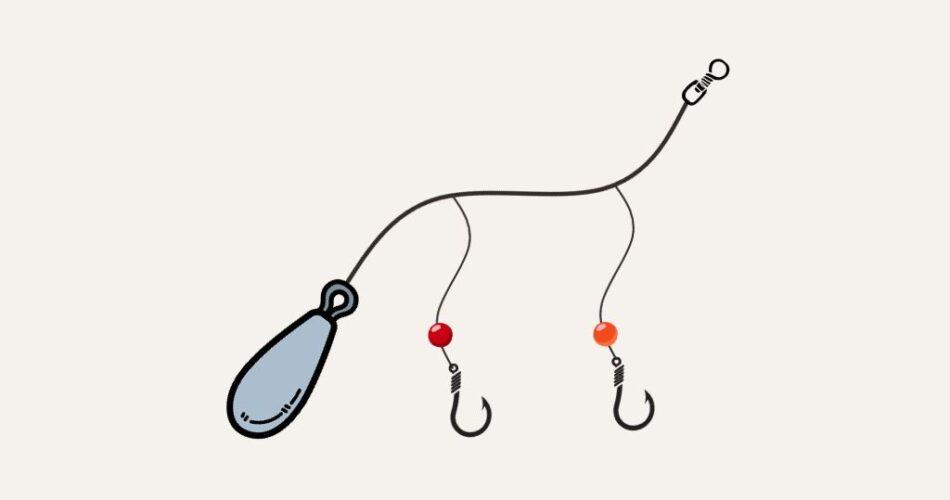The rigs you select for surf fishing are crucial to your success.
Think of it this way.
A rig is what presents your bait to the fish. It should, therefore, look appealing to attract more fish. An unattractive or poorly presented setup can be intimidating to the fish and drive them away.
On the other hand, your line configuration is what comes into contact with the structures you are fishing. Consequently, it should be durable and practical enough to reduce the risk of snags, cut-offs, and the loss of expensive tackle.
So, as you can see, your choice of rig significantly influences both your catch rate and overall productivity.
In simpler terms, the stakes are high, and a poor rig choice can severely impact your performance in surf fishing.
That’s why I wrote this long article.
Today, we will discuss the top 5 rigs for surf fishing, explain how to set them up, reveal their best use cases, and explore their drawbacks and potential pitfalls.
The goal is to offer you a complete guide that you can rely on to select the most suitable rigs for your fishing conditions.
So without further ado, let’s dive in.
A quick answer
If you are in a hurry and seeking quick insights into this topic, here’s a brief summary for you:
The best rigs for surf fishing are:
- The fish finder rig: A simple, yet excellent choice for most surf fishing cases.
- The Carolina rig: Similar to the fish finder rig but more effective in snaggy bottoms.
- The high-low rig: Allows you to cast multiple baits simultaneously, increasing the odds of hookups.
- The whole mullet rig: For aggressive and large predators.
- The pulley rig: To maximize distance and avoid snags.
Now, if you want a more elaborate answer, keep reading.

What makes a good rig for surf fishing?
As a general guideline, an effective surf fishing rig should meet 5 key criteria:
Appeal to fish
As mentioned earlier, your rig should look enticing to the fish and encourage them to approach the bait and strike. This involves ensuring an appealing bait presentation that mimics the appearance and behavior of prey.
Also, a good rig is one that looks neutral to the fish so as not to scare them away.
Here, it’s good to remember that less is usually more.
In other words, the more items you add to your line configuration, the more likely your offering will be intimidating to the fish, thereby reducing the chances of a bite.
Worth noting also that this factor (Appeal to fish) is the most important among all the others. Yes, the other criteria we will discuss in this section are significant too, but you can’t catch fish if they aren’t attracted to your offer.
Good stability
Stability is key when surf fishing.
As we discussed in a previous article, fish only hold and feed where certain conditions meet. As a result, they are likely to concentrate in tight zones and leave the rest of the surf empty.
So you can’t afford to let the currents push your bait around. You need to remain stable where you intend to deploy your bait.
One way to achieve this is by using rigs that resist currents well and cut through the water effectively.
As a general rule, minimalistic rigs perform better in rough surfs, and the more objects you cast, the more vulnerable you become to drifting currents
Good castability
When we surveyed 157 of our readers about the importance of casting distance in beach fishing, the majority (55.41%)—87 votes—considered it significant. Another 40% believed that, under certain conditions, their reach can have a notable impact on their success.
That’s why a good rig for surf fishing is also one that ensures good castability, or at the very least, does not hinder it.
Here also, the less is usually more.
The thing to remember here is that the more items you integrate into your rig, the more resistance you will receive from the air and wind during casts, thus limiting your reach.
Conversely, opting for minimalistic rigs with fewer components allows for better aerodynamics, enabling you to achieve greater casting distances.
Low snag risk
Rocky beaches are highly rewarding for anglers because they are rich in nutrients and feature many cover pockets that attract fish within fishermen reach.
However, casting into rocky grounds increases the risk of snags, line tangles, and the potential loss of valuable tackle.
A good rig for surf fishing is therefore one that minimizes the risk of snags when fishing snaggy shores fishing snaggy shores.
Here also, minimalistic rigs with fewer components are less prone to snags. Conversely, complex line configurations with numerous items are more likely to get caught on underwater structures, increasing the risk of unsolvable snags.
Simplicity
And finally, a good rig for surf fishing is one that is easy to set up. Here, it’s not only about the number of items involved but also the type of links and knots you need to assemble the rig.
This is especially important for beginners who want to get into the water as soon as possible and don’t want to waste too much time setting up rigs.
So those were the five criteria that a surf fishing rig should meet.
Worth noting that a good rig for surf fishing does not necessarily satisfy all criteria. However, the more criteria you meet, the more efficient and rewarding your line setup will be.
And again, the first factor (Appeal to fish), is the most important one.
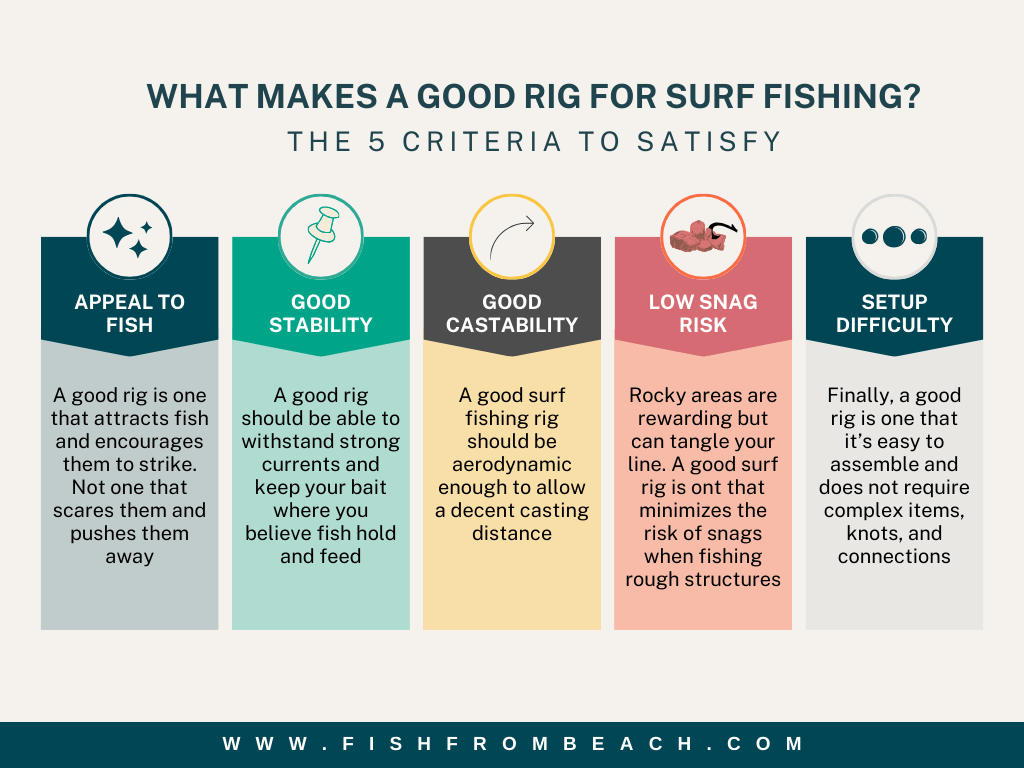
The best 5 rigs for surf fishing
Now, based on what we discussed above, let’s explore the best 5 rigs for surf fishing and how they perform in each area.
1- The fish finder rig
For me, the fish finder rig is the number one choice for surf fishing. It’s simple, minimalistic, yet very effective.
This rig is great for putting bait near the bottom and attracting bottom-dwelling fish like flounder, red drum, and striped bass.
A good thing about the fish finder rig is that it’s very easy to set up and doesn’t require a lot of gear. All it consists of is a sliding sinker, a swivel, a leader line, and a hook.
That’s all.
This is a big advantage for beginners and kids who want to try surf fishing without spending a lot of time learning how to tie knots and set up complicated rigs.
The simplicity of the fish finder rig also makes it good for casting long distances and staying stable in the surf zone. As we said above, when you cast too many objects into the water, you receive more resistance from the wind and current, which hurts your reach and stability.
But with the fish finder rig, you only cast a minimum number of objects, helping you to cut through the wind and currents more effectively.
Another advantage of the fish finder rig is that it makes your bait look natural and appealing to fish.
When you let the leader swing with the current, your bait moves just like the other things that fish like to eat, such as crabs, minnows, and other small creatures.
Also, when you let the bait move freely in the water body, you cover more ground and check different spots at the same time.
This increases your chances of catching something.
Now, the best part about the fish finder rig is that it incorporates a sliding sinker that allows the weight to slide on the line and not be attached to the hook.
This means the fish won’t feel the weight when they strike and as a result will have more time to swallow the hook before they realize something is wrong.
Some fish are very careful and won’t bite if they feel any weight on the line. But with the fish finder rig, fish can take more time to work the bait without getting suspicious.
This makes them more likely to bite and get deeply hooked.
Items needed:
- 3-4 oz pyramid sinker
- Sinker slider
- 1-2 ft leader
- 4-8 mm plastic bead
- #1 – 2/0 barrel swivel
- 1-4 ft leader
- Circle hook
The fish finder rig scores:
- Appeal to fish: 4/5
- Good stability: 4/5
- Good castability: 4/5
- Low snag risk: 3/5 (Pyramid sinkers are prone to snags. A good solution is to use spider sinkers)
- Setup simplicity: 4/5
How to set it up?
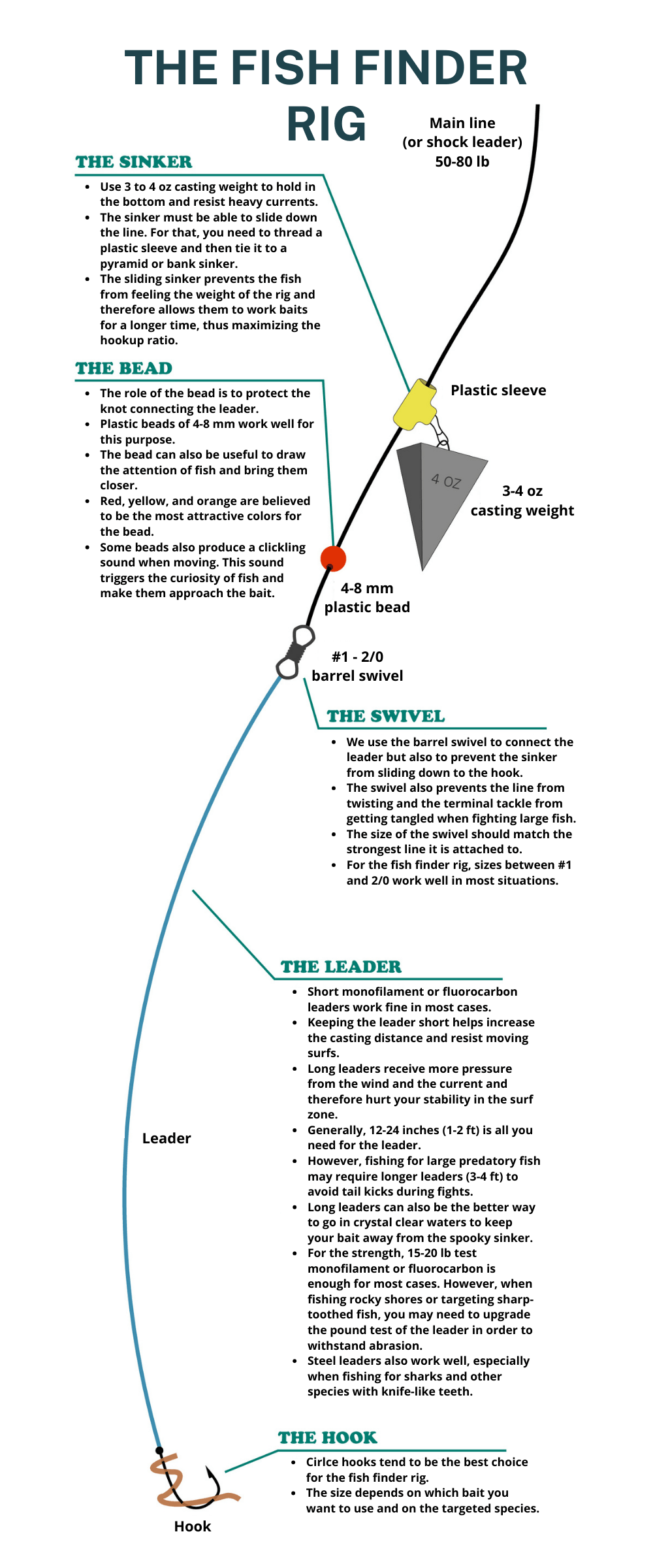
More details about the fish finder rig and how to set it up.
2- The Carolina rig
I’m not going to spend a lot of text explaining the Carolina rig because it’s quasi-identical to the fish finder rig with the same features and advantages.
In other words, the Carolina rig is as effective for surf fishing as the fish finder rig and can be used for the same conditions and objectives.
The only difference between the fish finder rig and the Carolina rig lies in the sinker design.
The Carolina rig incorporates a simple egg or bullet sinker, which allows the weight to move along the line (or shock leader) without requiring a plastic sleeve for this purpose.
This difference in sinker design makes them perform differently under specific conditions. The fish finder rig excels in rough surfs and strong currents, while the Carolina rig is better suited for mixed bottoms featuring grass, weeds, and rocks.
That’s because the pyramid sinkers we use for the fish finder rig provide a firm grip at the bottom to resist heavy currents and increase stability, but they can be prone to snags when used on rough shores with a lot of rock clusters.
The Carolina rig provides a good solution for this because ball and egg sinkers bounce and roll over more effortlessly on the seabed, which makes them less prone to snags.
With that being said, the Carolina rig can be a poor choice when fishing heavy currents because ball and egg sinkers do not provide a fierce resistance to strong water currents.
Read more about the pros and cons of egg sinkers egg sinkers
Items needed:
- 3-4 oz egg of bullet sinker
- Sinker slider
- 1-2 ft leader
- 4-8 mm plastic bead
- #1 – 2/0 barrel swivel
- 1-4 ft leader
- Circle hook
The Carolina rig scores:
- Appeal to fish: 4/5
- Good stability: 3/5 (Egg sinkers get swept easily under strong currents)
- Good castability: 4/5
- Low snag risk: 4/5
- Setup simplicity: 4/5
How to set it up?
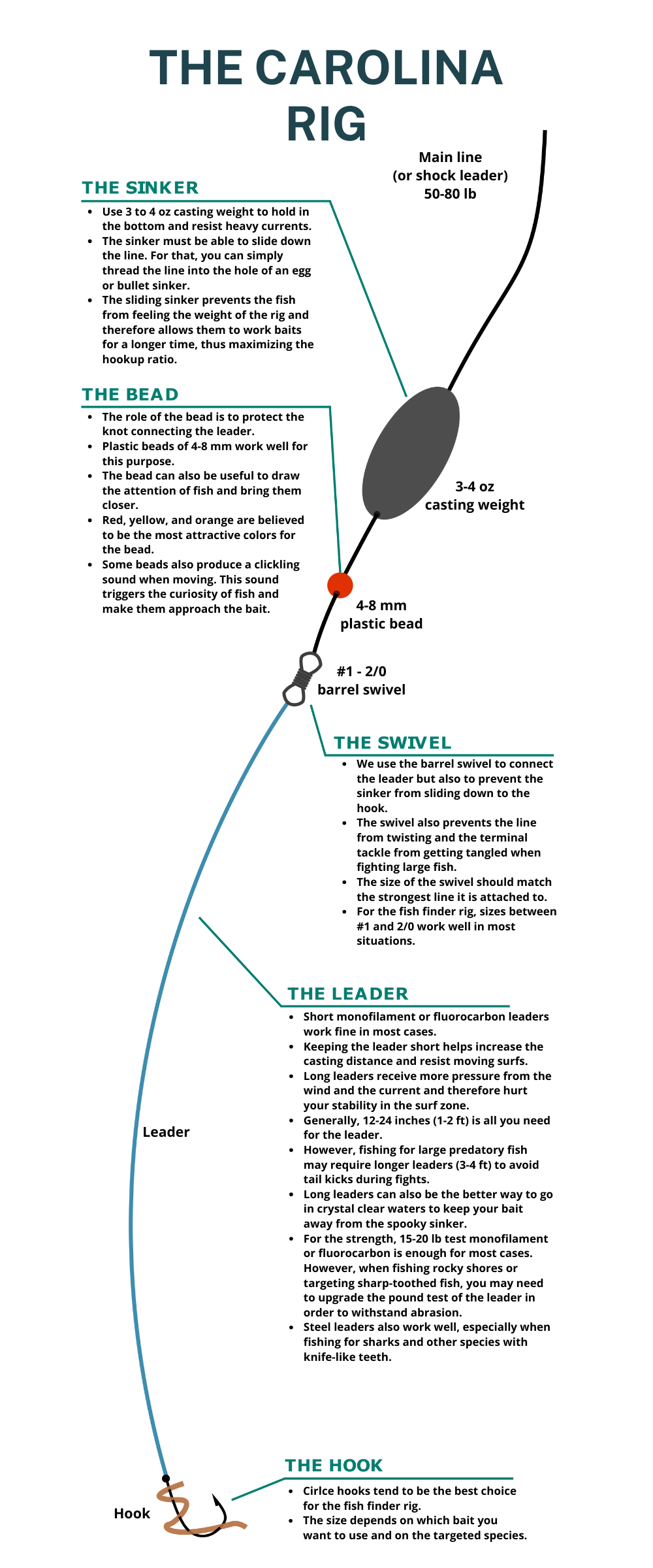
More details about the Carolina rig and how to set it up.
3- The high-low rig
The high-low rig offers the advantage of casting two baits simultaneously, increasing your chances of getting a bite.
It essentially allows you to fish twice as much in a single cast, resulting in more bites and more success.
This is particularly beneficial when targeting schooling species like pompano, sheepshead, herring, and whiting, as it can lead to double catches.
Another advantage of the high-low rig is that it allows you to try different baits at a time. This is a good thing to have, especially when fish have different diets and preferences.
Moreover, testing multiple baits in a single cast helps you quickly identify what yields the best results and adjust your approach accordingly.
Another big benefit of the high-low rig is to be able to target two depths simultaneously. This allows you to target more species with different feeding habits.
The higher hook is for the species that prefer floating food, and the second hook targets the bottom feeders that pick nutrients from the seabed.
The high-low rig also provides a decent bait presentation that encourages fish to strike.
For instance, the colorful beads and floats we add to this rig help to draw the attention of fish and bring them closer to investigate the offer.
Items needed:
- #3-#5 barrel swivel
- 18-20 inches leader
- 2 dropper loops
- 2 hooks
- 3-4 oz bank sinker
- Beads and floats
The High-Low rig scores:
- Appeal to fish: 5/5
- Good stability: 2/5 (Too many objects. More pressure from water)
- Good castability: 2/5 (Likewise, too many objects. More pressure from the air)
- Low snag risk: 2/5 (Again, too many items. More chances to grab rocks or seaweed underwater)
- Setup simplicity: 1/5 (Complex rig. Making dropper loops is not easy for beginners)
How to set it up:
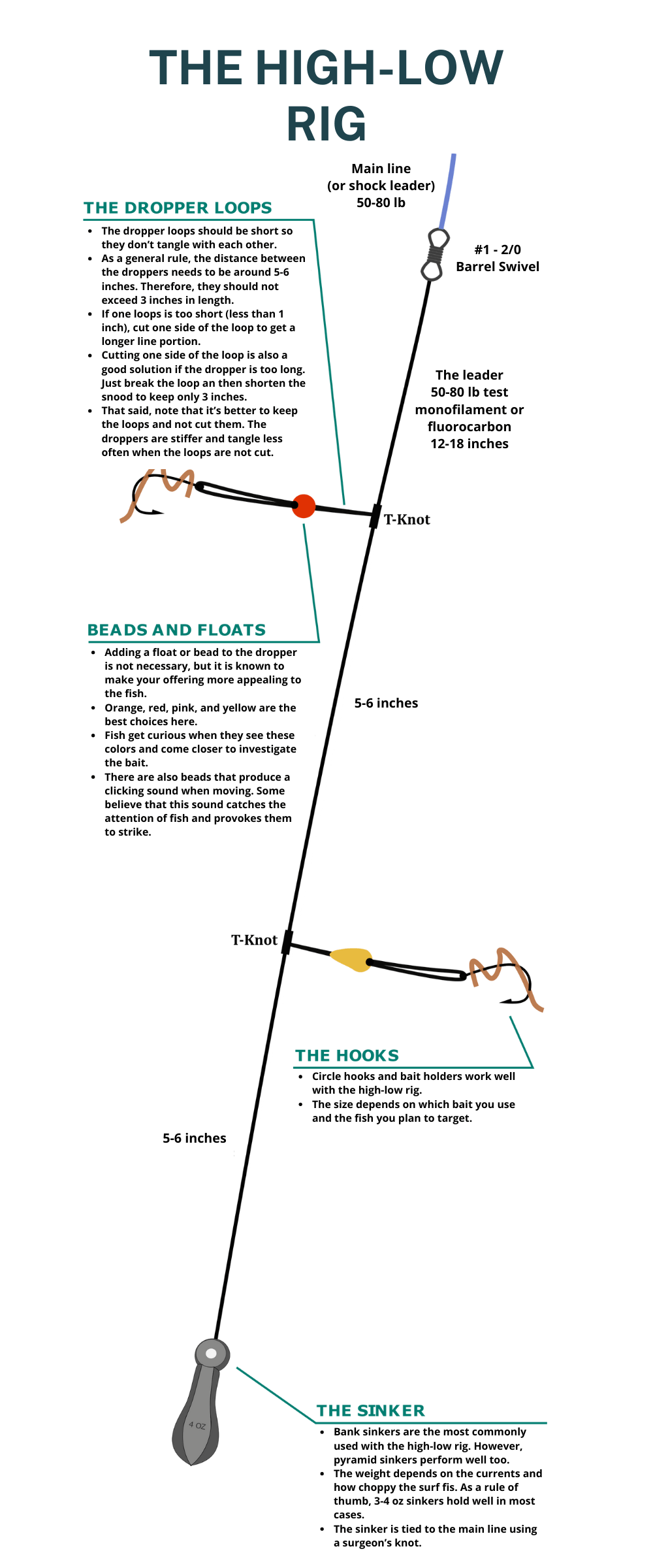
More details about the High Low rig and how to set it up.
4- The pulley rig
The pulley rig is specifically designed to tackle the challenges of fishing rough grounds rich in rock piles, grass, and kelp.
By incorporating a sliding pulley system, this rig offers a brilliant solution to minimize the risk of snags.
When a fish strikes and takes the bait, the pulley rig allows the fish’s weight to effortlessly pull the sinker off the bottom, keeping it away from potential obstructions.
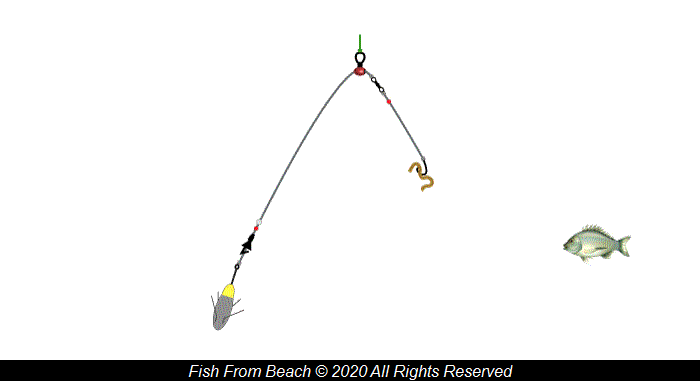
This intelligent design ensures that, immediately after the bite, the sinker positions itself ahead of the fish, significantly reducing the likelihood of your terminal tackle getting snagged in bottom structures.
The pulley system also minimizes the chance of the fish using the weight of the sinker as leverage to escape.
In addition to its snag-minimizing capabilities, the pulley rig offers an impressive aerodynamic presentation that enables greater casting distances.
It’s therefore a good choice if you want to target sharks, tuna, cod, and the other species that require decent casting reach.
Items needed:
- A pulley bead
- 3 plastic beads (4mm)
- 3-4 oz Spider sinker
- Crimp sleeve
- Impact shield
- Rig body and trace
The pulley rig scores:
- Appeal to fish: 2/5 (The bait stays suspended in the water body. Not all fish want that)
- Good stability: 4/5
- Good castability: 5/5
- Low snag risk: 5/5
- Setup simplicity: 0/5 (The pulley system and bait release mechanism are not for beginners)
How to set it up:
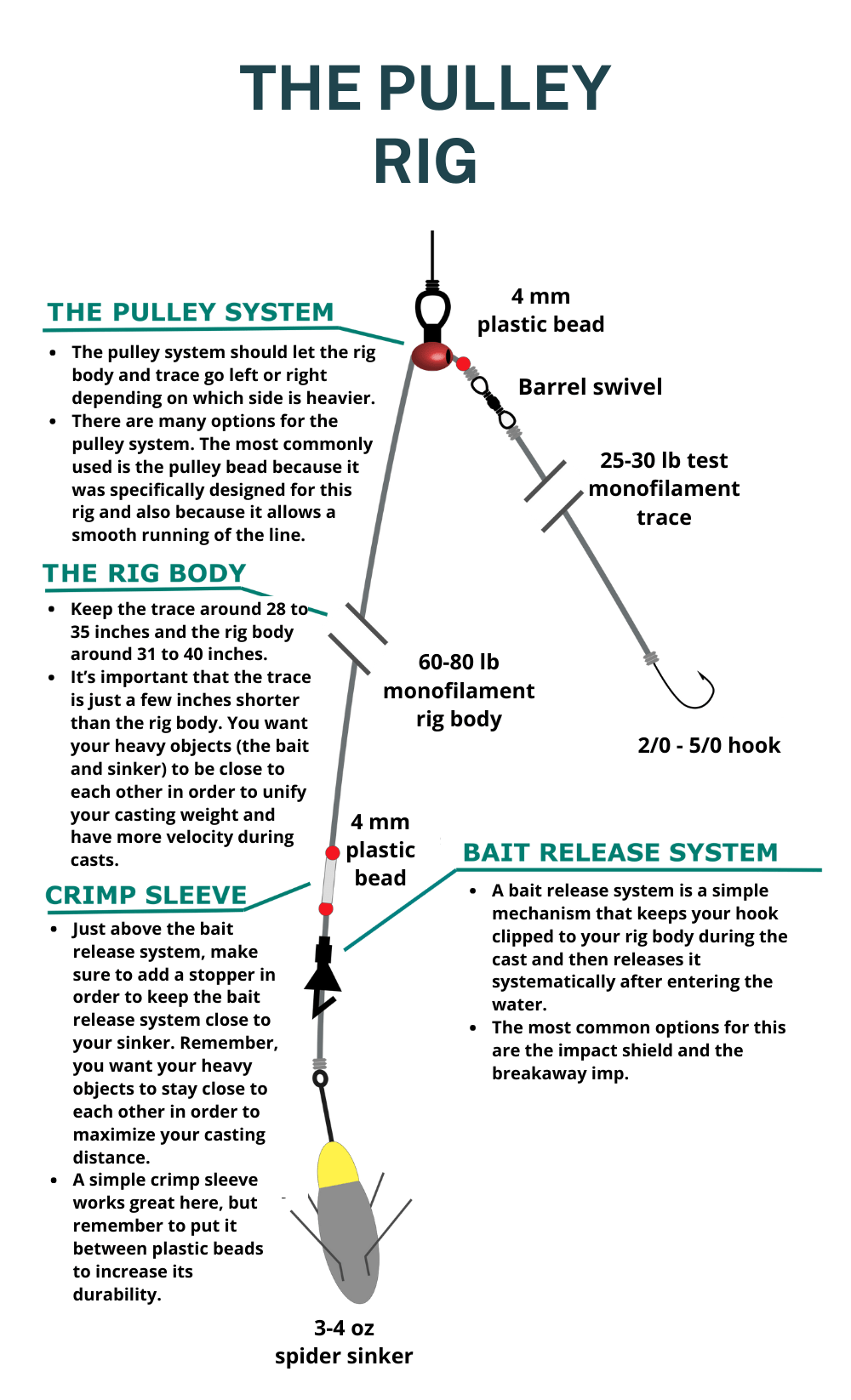
Read details more about the pulley rig and how to set it up.
5- The whole mullet rig
The whole mullet rig is very effective with bluefish and other predatory fish that attack prey from the tail.
It’s therefore a species-oriented setup that is designed based on the feeding behavior of bluefish and the way they approach prey.
Let me elaborate.
Bluefish are known to strike baitfish from the tail section. Their typical feeding behavior is to pursue fast-swimming prey and catch the slowest/weakest ones from behind.
That’s where the mullet rig comes into play. This line configuration requires putting the hook in the tail of baitfish (typically finger mullet) so that when the blues strike, you have a better chance of grabbing their jaws.
Now, while it’s true that the mullet rig is more geared towards bluefish, it has also proved to be effective with many other species we catch from the surf.
Fish such as striped bass, redfish, albacore tuna, and sharks all exhibit predatory feeding behavior, which suggests that they generally don’t care whether to hit baitfish from the tail or the head.
It is therefore possible to catch all these species using the whole mullet rig.
In fact, the mullet rig is a great setup when you are interested in big catches only.
Using a whole mullet (or any other baitfish) is generally more tempting for large predators and intimidating for pan-sized fish. So it is very likely that you will only experience heavy bites with this rig.
Another advantage of the mullet rig is that it features a styrofoam float before the hook which helps keep the bait suspended in the water body and hence away from crabs and the other unwanted species that steal bait at the bottom.
Items needed:
- 3-4 oz bank Sinker
- Styrofoam
- 5-6 inches steel leader
- 3-way swivel
- 12-18 inches leader
- 3/0 – 5-0 double Hook
The Whole mullet rig scores:
- Appeal to fish: 2/5 (When you throw a whole baitfish, most fish will either slowly steal from it or become intimidated by it. Only large fish will be able to swallow it whole)
- Good stability: 2/5 (The foam receives a lot of pressure under strong currents)
- Good castability: 3/5 (Not aerodynamic a rig)
- Low snag risk: 3/5
- Setup simplicity: 3/5
How to set it up:
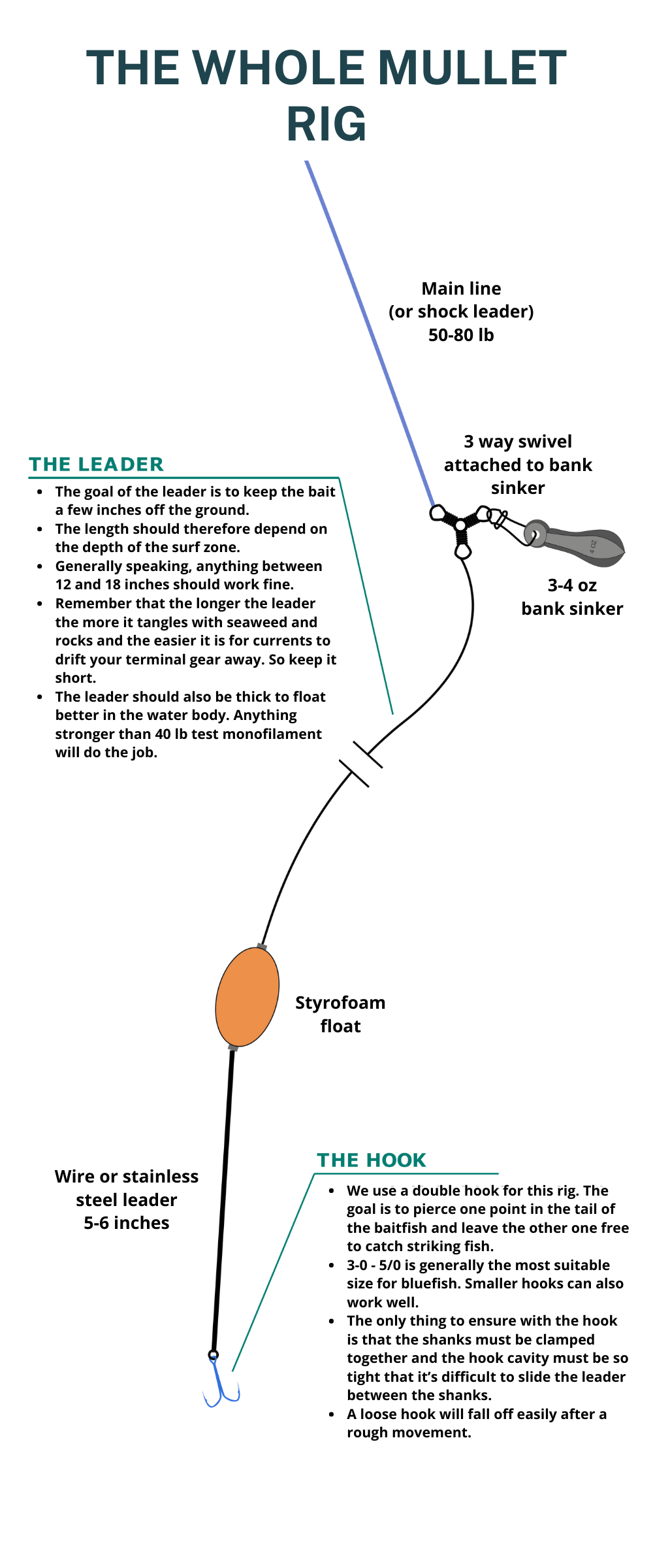
Read details more about the whole-mullet rig and how to set it up.
What is the best rig setup for surf fishing?
After exploring the top rigs for surf fishing and assessing their performance in various conditions, one might wonder which rig to choose if only one can be brought to the beach.
In other words, which rig is considered the overall best choice for surf fishing?
Well, an easy way to answer this is to visually review our previous discussion and select the line configuration with the highest scores:
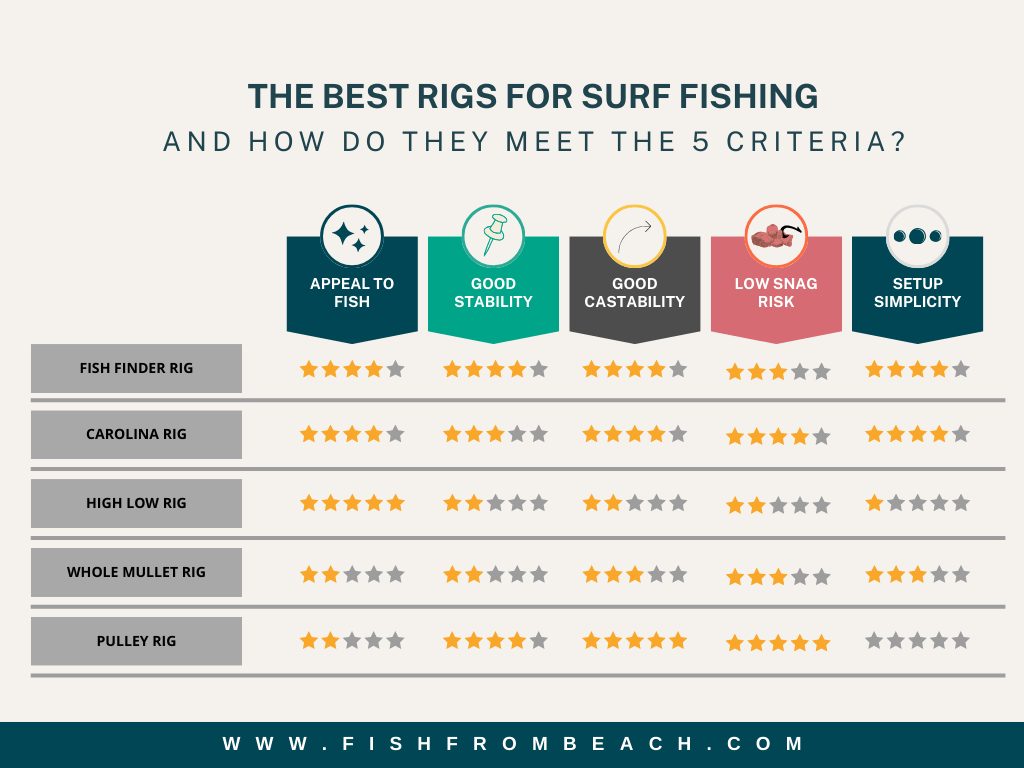
As you can see, both the fish finder rig and Carolina rig consistently score the highest in all five criteria. These setups are not only enticing and appealing to fish but also demonstrate practicality in terms of stability, reach, simplicity, and resistance to snags.
So without a doubt, the fish finder rig and Carolina rig are the top 2 choices for surf fishing.
The High-Low rig comes third primarily due to its impressive score in attractiveness and appeal. As said earlier, this factor is the most important among all others. That’s why despite its lower scores in other criteria, the High-Low rig has the potential to deliver outstanding results when brought to the beach.
It may even outperform the fish finder rig and Carolina rig under certain conditions.
The whole mullet rig and pulley rig come last in the ranking due to their lack of appeal and attractiveness.
In the case of the pulley rig, while it excels in castability, stability, and resistance to snags, its consistent suspension of bait in the water may not always be optimal, particularly in situations where only bottom feeders are present.
Also, the pulley rig is hard to set up and assemble, which makes it less suitable for beginners and starters.
The whole-mullet rig on the other hand needs large baitfish to work, which is intimidating to most creatures in the nearshore food chain. As a result, very few fish are attracted to this rig.
As explained above, the whole mullet rig is a good choice only when you only want large and heavy catches and are willing to wait long hours between bites.
What do surf anglers say?
Another way to answer the previous question is to seek the opinion of actual fishermen.
That’s what we did in our surf fishing survey by asking 170 of our readers about their favorite surf rig. The results weren’t very surprising. The fish finder rig claimed the top spot with 32% of the votes, indicating its widespread usage and proven performance.
Close behind was the high-low rig, which garnered the favor of 30% of respondents, and then the Carolina rig with 24% of the votes.
The pulley rig and whole mullet rig occupied the fourth and fifth place, respectively, with a combined 9% of the votes (15 respondents).
Comparatively less common options encompassed the dropper loop rig and fireball rig, which can be considered as slightly adjusted versions of the high-low rig.
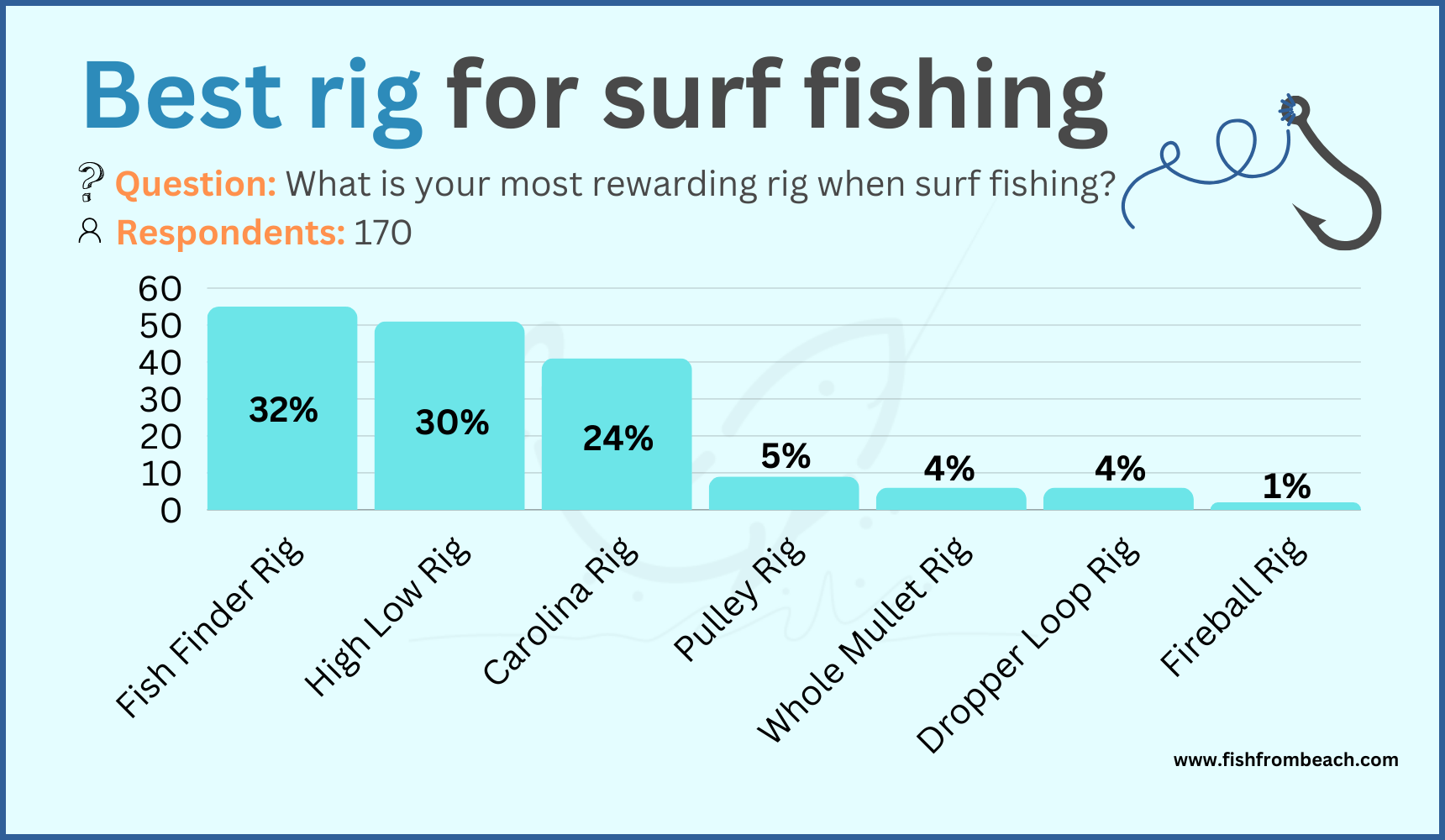
So what we can conclude from these figures is that the fish finder rig and its similar counterpart, the Carolina rig, stand out as the best and most favored setups for surf fishing within the community. However, the High-Low rig remains a popular choice, especially considering that some anglers opt for similar setups like the dropper loop rig and fireball rig.
The whole mullet rig and pulley rig are not so popular, but since there are fishermen who consider them to be “the most rewarding”, it’s safe to say that they work great in certain regions or under certain fishing conditions.
Last word
Now that you have a clear idea of the best rigs for surf fishing, how to set them up, and how they perform under different conditions, it’s important that you always fill your gearbox with an abundant supply of all the necessary items and tools to make these rigs.
This includes a variety of sinkers, swivels, leader lines, hooks, and a range of leader and float options.
Having an ample quantity of these components ensures that you have what it takes if you need to set up a new line configuration or adapt to changing conditions.
To further enhance your fishing productivity, it is highly recommended to prepare or buy 4-5 preset rigs for each option.
This means having multiple rigs already assembled and ready to use for different fishing scenarios.
By having preset rigs, you eliminate the need to tie knots and assemble the entire rig from scratch each time you want to switch bait presentations.
Having preset rigs also allows you to quickly adapt and modify your setup based on what is working and producing the best results.
In other words, preset rigs give you the advantage of being able to respond promptly to changing conditions or fish preferences.
If you notice that a particular rig is attracting more bites and generating more catches, you can easily switch to that preset rig without wasting so much time.
This ability to switch rigs efficiently provides you with the agility to experiment and find the most effective approach in any given situation.
Note (*): If you make a purchase through links from this website, we may get a small share of the sale from Amazon or other similar affiliate programs.
Surf Fishing Survey
Help us provide you with better content by answering simple questions about your surf fishing experience and knowledge.
We will put the collected responses together and turn them into valuable information that will help you catch more fish from shore 😉
Note: No personal information will be collected with your answer.

